Evolutionary Biology Term Test 1
Table of Contents
Ch. 1 - The Whale and the Virus
Ch. 2 - From Natural Philosophy to Darwin
Ch. 3 - What the Rocks Say
Ch. 4 - The Tree of Life
Ch. 5 - Raw Material
Ch. 1 - The Whale and the Virus
Evolution isn’t just a theory, it is a scientific theory, meaning it explains and backs many laws and things we see in the world.
Theodosius Dobzhansky: “Nothing makes sense except in the light of evolution”. It’s really satisfying thinking about how it all came to be.
Evolutionary biology can help with - fighting viruses, predicting climate change and invasive species, as well as answering questions such as “How did we get here? How did we acquire out powers of reason and language?”
Biological evolution: The study of the processes by which life evolves and the patterns these processes have generated over the past 5 billion years
We study DNA, fossils, and use computers to analyze our data to find most likely possibilities of evolution
Whales: Mammals Gone to Sea
The blue whale is the largest animal to exist on earth ever, weighs about 100 000 kg, and is 30m long.
Cetaceans: Whales, dolphins, fishlike bodies, use relatively small amounts of energy to shoot through water. Generate thrust from tail moving side to side like sharks. Embryos develop in uterus, forming placentas, and hav tiny bones in flesh where hip would be on land mammals.
Natural selection: the process of lineages evolving marine mammals
Homology: structural characters that are shared because they are inherited from a common ancestor
Skull is very helpful at connecting species
Mammals all hear with this same three ear bones, and the dorudon also has a thick layer form inside where they would be referencing them.
Mouth anatomy of baleen whales or mysticetes. There are two basic forms.
Why do some have baleen - swim around and catch fish. Get huge amounts inside, like entire schools. One giant mouthful. Water squirts back out through combs, leaving just krill.
Mysticetes were completely replaced, still have teeth genes but they were disabled.
Peg shaped teeth to hunt for prey
The change occured after cetaceans became aquatic
Dorudon in its teeth - the dorudon is more similar to living mammals than to living odontocetes. Sees the first reduction in hind limbs.
Involucrum - part of the ear in modern dolphins and pakicetus
Synapomorphies - related to sympatry. Existed in same geographic area, similar common ancestry of traits.
Pakicetus was the prior to dolphins and whales - fossils found where they reside today
Want to know which group of land mammals that cetaceans specifically came from
cows, goats, camels, and hippopotamuses. Artiodactyls.
Hippopotamuses
Shared recent common ancestry based on astragali
The pelvis is jammed in the tail and still has femur and tibia.
We look at the 18O/16O ratio, which is higher in saltwater and higher in teeth of marine animals
Some animals were mostly in freshwater, but others were completely seawater. Shows a change from freshwater to sea, or that it did both.
Whale’s synapomorphies with mammals: mammary glands, three middle ear bones, and hair in developing embryos.
Convergent evolution: similarities with between whales and fish. Attained similar traits separately, homoplasy.
Astragalus - in our ankle between our tibia and fibula.
Cats and dogs are digitigrade (walking on digits). Cow, pig and horse are unguligrade (walking on tips of digits). We are plantigrade (whole foot on ground). - All have the same bones though.
Phylogeny: Branching patterns of evolution, synthesize evidence of a complex evolutionary history
Morphological - form and structure of organisms
there was no morphological evidence that dodunces and pakicetus were related to water animals.
The indohyus and pakicetus had dense bones found in hippos. Able to stay underwater. They likely swam like otters, kicking large feet that they dragged on land. Became obsolete, even costly.
Seawater was more dense in oxygen atoms. Pakicetus drank fresh water, while ambulocetus drank a mix of sea and fresh. Gene activity related to change.
Leg building genes in dolphin embryos are active and then stop growing. A mutation stops them likely from occurring.
Cetacean brains: Biggest brain proportional to body (besides human). Earliest whales had relatively small brains. Only after water did they change drastically. Living in large social groups, forming alliances, needed a bigger brain to process social information.
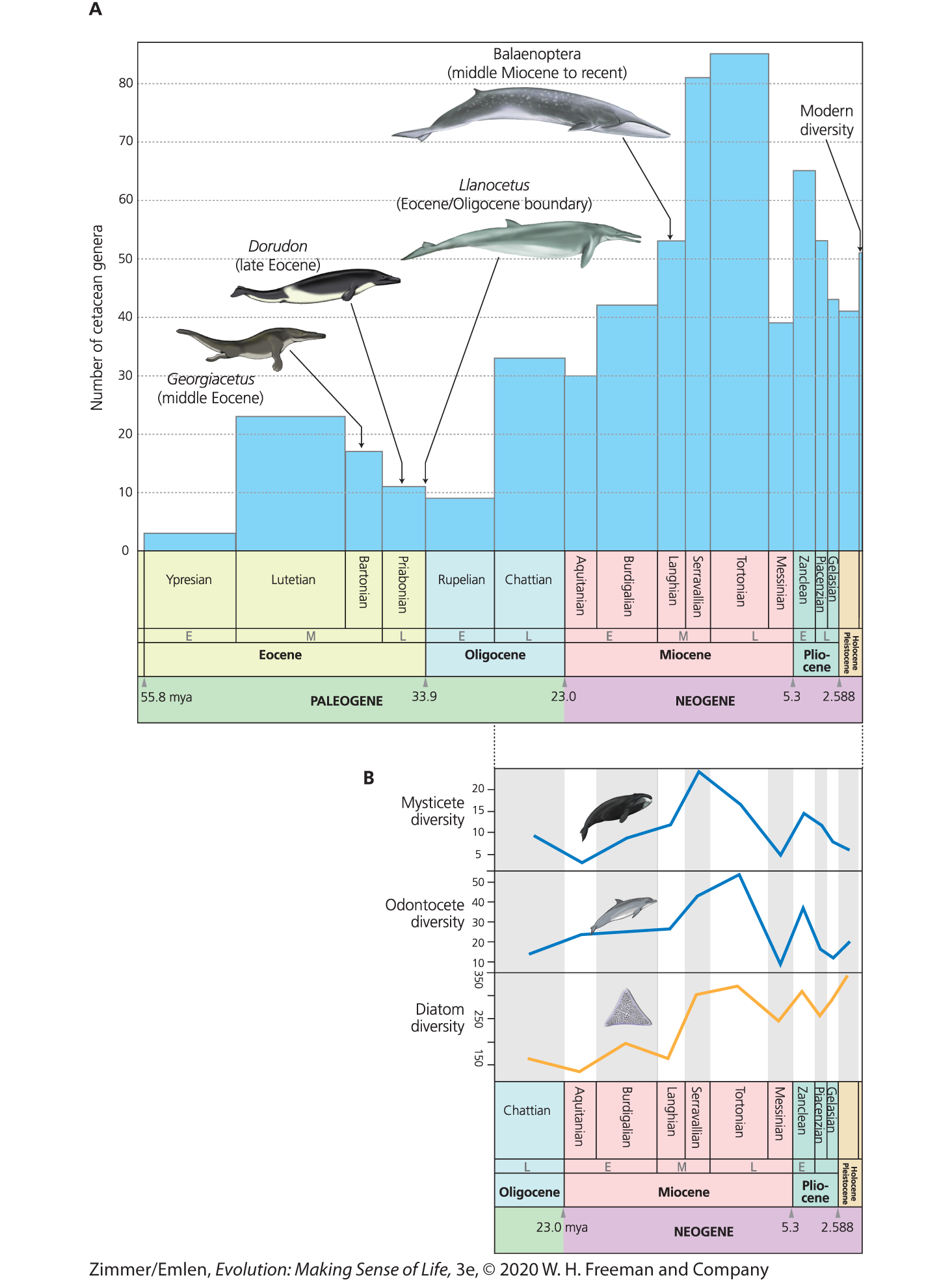
Mysticetes: trapped small animals with their baleen.
Odontocetes: swam after fishes and larger prey.
Cetaceans have attracted a predator in humans.
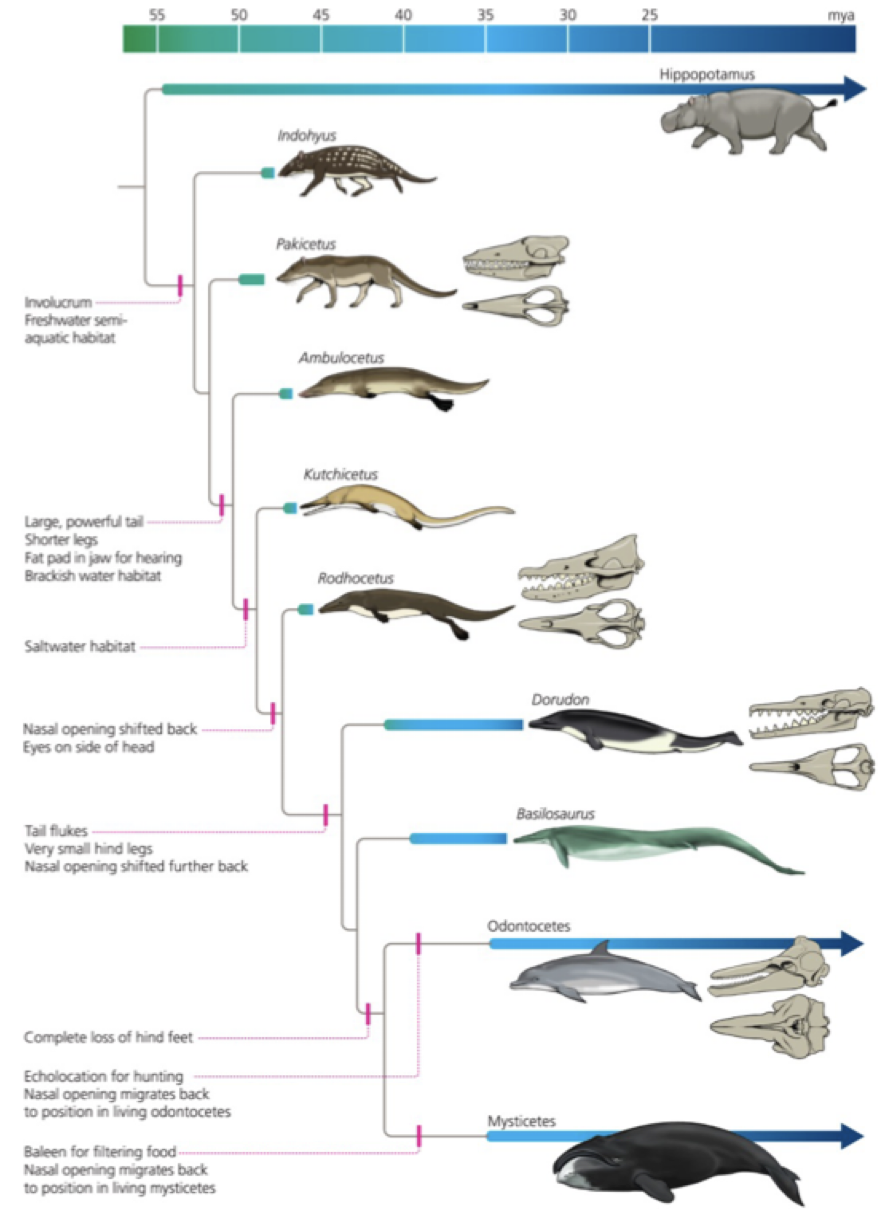
We documented all of this through isotopic analysis of fossil teeth, fossil analysis of hindlimb loss, and embryonic analysis linked to gene expression
Viruses: The Deadly Escape Artists.
SARS-Cov-2 is 50-140 nm diameter and 1000x smaller than width of hair. 26 protein coding genes.
Viruses can evolve at even shorter timescales, over months or days.
Influenza virus: membrane and proteins shell encasing strands of RNA. Invades host cell. Hemagglutinins bind to receptors of epithelial cells in host respiratory tract. Triggers cell to open and then move inside the virus and mass produce copies of themselves. The virus also cuts themselves free from the cell.
SARS-Cov-2 lifecycle: Spike bind to ACE-2 receptor, allow certain things to pass, fool to gain entry, opens and excretes RNA genome. Can’t replicate so it uses ribosomes and mechanisms to copy all its genes. Creates spike proteins and is ejected.
Most related to bat version, through zoonotic transfer. Belief of pangolin effect.
Mutation happens that doesn’t stop, continuously evolving new varients.
Mutations allow viruses to evade the immune system, changing what antibodies can bind to. Proteins of viruses swap genes.
Strains of influenza ultimately descend from birds and bird flu crossing over.
Viral reassortment: viruses swap genes, undergo gene shuffling (2 viruses) and become packaged into protein shells. Surface proteins are distinctly different and humans lose immunity to it. Added urgency to detecting new flu strains.
H1N1 is the version of spike protein. Made its way into humans, has elements from chicken and duck. Constantly reattaining new genes. Shuffle up genome to become more infectious than we become resistant.
H7N9 spread form mostly from bird to human, rarely human to human. Quite deadly. Most common anti-virals weren’t doing anything.
Added lecture section
Humans and chimpanzees share a common ancestor. We’ve existed for like 5-7 million years. But in evolutionary terms that is considered pretty recent. 5-7 my of divergence and our genomes are 99% identical to what they were.
Study evolution:
Find new ways to fight the viruses and bacteria making us sick
Understand how insects become resistant to pesticides
Understand the ramifications of human impact of the planet.
Learn today’s extinction’s in comparison to the past. Help make predictions and devise strategies to combat the current wave of extinction.
Macroevolution - evolution across millions of years
Microevolution - allele frequencies change across generations. Both are evolution.
Ch.2 - From Natural philosophy to Darwin
Conceptions of Nature Before Darwin
There was an understanding that plants were similar, and naming helped people understand that.
Plato: Typological thinking - every organism is an example of a perfect essence or type, created by God. Believed that types were unchanging
Aristotle: Ordered organisms into linear great chain of being (or scale of nature)
The great chain of being: Species were put on a scale of lowest to highest forms and were fixed types. Plants were the lowest forms of life, humans listed higher due to ability to reason, and it was seen as God’s creation of it. Increasing size and complexity.
Linnaean classification: Discovered/introduced taxa and taxonomy. Assigned every species to a particular genus, family or order based on traits it shared. There was a belief of hybridization coming after the bible. Nested hierarchy. Gets further out and more and more inclusive.
Katy Perry Came Over For Good Soup
Fossil records: Nicholas Steno was a dutch anatomist who dealt with things like fossil records. After sharks died, teeth were transformed to snow. Sedimentation over mountains were things originally on the ocean floor.
Stratigraphy: studying the layers of the earth
Natural theology: Building on classic work and anatomical research in ancient Greece. Studied organs and functions. Compared old hearts of humans, snakes and fish to what had been drawn up in ancient Greece to current hearts.
Structure was so well crafted to its state of being, and the chain of being was considered in how much bigger brained individuals were on the list.
Mechanical function: seen as evidence of God’s divine creation
Complex organs were noted and later the powerful explanation of Darwin emerged through evolution by natural selection
Evolution before Darwin
Buffon thought the world form was due to laws of physics over 70 000 years ago. We also saw the idea of same particles between rocks and humans coming to be. Different regions have distinct plants and animals, life emerged as distinct types based on their environment.
Paleontology popularized, discovering fossils of species that no longer exists.
Georges Cuvier: Compared elephants from Africa and India, and the idea of extinction. Fossils resemble modern species, and many were extinct.
Extinction - left blanks in the great chain of being
Mary Anning: British Naturalist, discovered many early fossils, and the concept of extinction was met with considerable resistance.
James Hutton: Scottish chemist and geologist. Rocks formed through imperceptibly slow changes, many of which we can see around us today. Small changes accumulated over time, and so he believed the earth was very old.
Rain erodes, molten rock pushes and creates. There is a cycle of erosion and tiny changes over time.
Smith: organized strata by oldest to youngest (of fossils) and began forming a geological history. Answers for extinction in rocks below. Created the first geological map. Same layers of rock in different parts of England.
Surface features into strata, some at surface, some below the surface, some exposed at different places in the surface.
Cuvier: mapped out the geology of other parts of the world, discovering that formations of rock exposed in one country could often be found in others. Very similar levels (maybe not always as many layers)
Lamarck’s theory of evolution: Life was driven from simplicity to complexity. Believed that evolution happened in a giraffe reaching up high so its neck’s nervous fluid would stretch. Became popular because it was intuitive, however biologists rejected it because of how it was phenotypically relied on genetic mechanisms of inheritence.
The Unofficial Naturalist
Fitzroy brought Darwin on the HMS beagle for five years, where they went to South America and Darwin stopped to trap birds, find fossils and collected barnacles. Earthquake in Chile led to uniformitarianism understanding. The earth became by small changes (Hutton’s hypothesis). Finches all had different beaks.
Uniformitarianism: same observable natural processes today were also responsible for events in the past. Slow process of erosion, over long time, can produce massive canyons. Torrential rain, impromptu stream set up with water, can end up forming a trench.
Charles Lyell: principles of Geology
Things were presented to Linnaean society, and not much happened with Darwin’s theory of evolution until the book was released. Few disagreed with him in terms of “life evolved” but many people wondered how it occured.
Homology: born based on the idea that we were all cousins and how we have very similar bones structures even with different functions. Also known as a synapomorphy.
Homologous trait: similar due to inheritance from a common ancestor
Humans begin to form gill arches, but then develop into a heart and we still have the weird branching patterns. Brain nerve goes from brain to heart to brain and is right next to where it left
Overturned ideas that species are unchanging, replaced typological thinking with population thinking, scientific, proposed mechanism that could account for change through time, predictions could be tested through observation and experimentation.
Malthus: believed poor people naturally selected against, which led to Darwin and Wallace’s hypotheseses. A grim proposal.
Wallace: proposed similar evolutionary ideas, collections from south america and Malay Archipelago, observations of biodiversity, common ancestry, natural selection.
Wallace and Darwin presented letters to the Linnean society.
Similarities: Change is not linear progression, based on variation amongst individuals in populations, population thinking rather than typological thinking, individuals with certain traits produce more offspring than others without these traits.
Darwin’s ideas in the Twenty-First Century
While there, earthqual shifted ground up to 4 cm. He found fossils similar to todays species (giant armadillo is similar to an armadillo). Different islands had different types of tortoises you’ll see. Higher vegetation (high in air) you have saddled shape tortoise shells.
Mating behaviours effected sexual selection. How fast embryos grow is effected by selection. Darwin liked heredity and genetics to select for traits, and then later on (1950s) DNA and the double helix was discovered.
Volcanic islands with no tall vegetation had iguanas adapted to swim in order to feed on submerged lava rocks.
Darwin’s pigeons: Take the whitest feathered ones and breed them with each other over and over again.
Artifical Selection: Humans are selective agents (breeding), and they exagerate traits not seen in nature. Breeders can do it, so can we with nature.
Moment of catastrophe: The resources and population meet, there is not enough to sustain population and the population will crash.
Descent with modification was the big thing Darwin was going for.
Darwin postulates:
Individuals within a species are available
Some variations are passed to offspring
In every generation, more offspring are produced than can survive
Survival and reproduction is not random
Ch. 3 - What the Rocks Say
We have long since debated the age of the earth, and Darwin found gradual erosion over the course of 300 million years, even up to a billion. Kelvin had a skeptical theory of this based on the fact that it wasn’t hot or col enough.
Kelvin: Argued the earth was no more than 20 million years old. He was proved incorrected. He thought since the Earth was hot and had been cooling, then it must still be young, but the earth is not static. Movement of tectonic plates has changed the actual way the heating up and down of the planet has been going.
A Curious Lack of Radioactivity
Neutrons and protons differ and are placed as a superscript. Carbon-12 is stable (6P, 6N), carbon-14 is unstable (6P, 8N).
Version of atoms that are unstable (amount of protons or neutrons) decay and have a half life. Tube of carbon-14, at what point is half of it still carbon-14. The rate is exponential.
Carbon-14 half life is 5730 years. 50% of it will become Nitrogen-14 in 5730 years.
Still found on earth - Samarium-147, Rubidium-87, Rhenium-187, Thorium-232, Uranium-238
A Vast Museum
Fossil chain didn’t explain Darwin’s theory greatly, because things were missing. They studied the process of fossilization for why certain things fossilized and others didn’t.
Things get eaten, sun beaten, rain soaked, and nothing is left to fossilize. Paleontologists need to get fossils briefly before exposure and destruction.
Fossils are aged by discovering the layer of rock they are under. You can find the bracket of time in which they existed. You can also use organic material (Carbon-14) for things less than 50 000 years old.
Bringing Fossils to Life
First figure out where it fits on the tree of life. Fossils show how an organism aged and how they developed into things later. Found melanin in bones with X-ray spectroscopy.
Countershading: cancels out darkening shadows, makes it harder for predators to see them (smaller animals).
Computed tomography (CT scanner): where we resonate and produce sounds and just analyze what things sounded like.
Fossils all went through a low oxygen phase
Traces of Vanished Biology
Lump of coal - remains of dead plants
Biomarkers: How plant materials are transformed, sediments.
Geochemists determine that fossils were found and what they went through to be formed by biological processes
Okenane: purple sulfur bacteria that makes the pigment.
Extinct animals diets can be found through whether they ate C4 plants and C3 plants (higher, lower carbon respectively).
Molten rock was cooled down, hot on the inside, and then hard on the outside.
Life’s Early Signatures
4.1 billion years ago
Carbon came from volcanoes and things similar. We’ve pushed our fossil record to be 3 billion years old.
Stromatolites: Large mounds built today by colonies of bacteria, grown on floors of lakes and shallow seas. Form when biofilms of microorganisms, especially cyanobacteria, trap and bind sediments to form layered accretionary structures.
The Rise of Life
Living microbes are hard to distinguish as there is a huge phylogeny of bacteria. Cyanobacteria was carrying out photosynthesis and creating oxygen. Life began and was dominated by microbes then and even now it still is.
We then moved from single-celled organisms to multi-celled organisms, and we saw life getting bigger. Animals began to leave fossils at like 3 billion years ago.
We then saw the rise of the animal kingdom by organsims swallowing other organisms. Sponges were animals with distinct chemical biomarkers, and had muscles and nerves.
Enigmatic species: edicaran fauna. Measuring a whole meter in length, looked to be like snails and clams. Only distantly related to these lineages though. Independently evolved multicellularity.
Not all of these cambrian species are left over. 90% went extinct during mass extinction.
2.6 billion ya, things began to climb ashore in south africa. Larger plants had greater biodiversity, and complex forests began to develop. Tetrapods showed up because fungi were feeding on dead plants and there was a lot to be done
Recent arrivals
Teleosts: most species of fish on earth pulled up 350 million years ago.
Synapsids: dominant vertebrates relative to todays mammals (sprawling creatures) pulled up 200 million years ago.
Flowering plants were well accepted fossils of flowering plants, dating back to 136 million years ago. Grasses were most widespread of the flowering plants.
Hominin evolution: key genetic and behavioural changes. 7 million years old.
Lecture notes
Weald: identified the rolling hills and valleys in England
Darwin: If there was gradual erosion then, Weald’s information put the earth at 300 million years ago, then the Earth must actually be billions of years old
Dating Earth’s layers - Geologists identified numerous rock layer around world (1800), mapped layers into chronological order. This estimated the earth to be 4.56 billion years
Ch. 4 - The Tree of Life
Tree Thinking
Darwin started out by seeing branches in the earth, and how things seemed to be connected, getting complicated differently than just a chain.
Succession: growing tip of the branch
Phylogeny: evolutionary history of a lineage or lineages. Can depict populations, genes, species or higher taxonomic units.
Phylogenetic tree: visual representation of phylogeny, can look different and depict the same thing. Don’t read along tips, look for common ancestry.
To construct a phylogenetic tree:
Node: links kinship, or “same parent” of two different species, represents common ancestor of all descendent lineages
Internal nodes: located within the phylogeny, representing ancestral populations, or species that have long since disappeared
Clade: node and all of its descendents
Cladogram: shows only the relationships among species
Taxa: units of classification
Branch: Separates a group, lineages evolving over time; connects successive speciation events or other branching events
Designs may lead to miscommunication between scientists, and we can try and condense into a clade.
Phylogeny and Taxonomy
We changed from having hierarchy systems. Evolution explained nested hierarchies. Relative order helps infer lineages. Phylogenetic history shows how taxas should be group.
Monophyletic: group of an organism and all of its descendants
Polyphyletic: cutting the tree in two. Shared characteristics, grouping not based on common ancestor.
Paraphyletic: includes some but not all descendents of a common ancestor
Fish is paraphyletic because we ignore the mammals that arise from common ancestry.
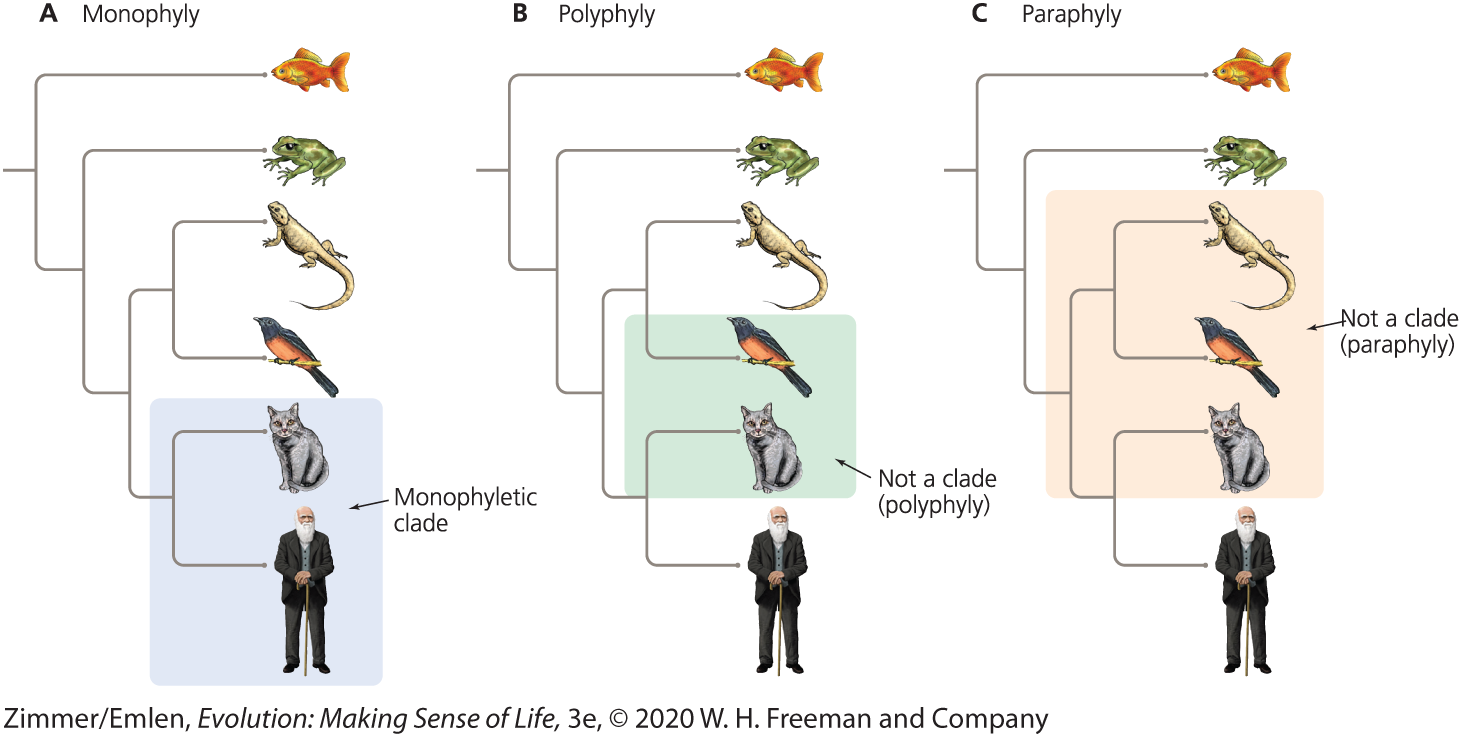
Reconstructing Phylogenies
We gather data to generate hypothesis, and can use a score to measure characters in a taxon.
Carnivorans (group of mammals) - enlarged side teeth, sheer meat off their prey
Synapomorphies: shared derived characters, evolved in the immediate common ancestor.
Outgroup: how we decide what is ancestral and what is derived. Comparing carnivorans to another species outside of the clade, we see them as an outgroup in order to decide when they got their teeth. We see what traits looked like before.
We evaluate hypotheses using a matrix of species score for the list of characters
Homoplasy: similarities of independent evolution of same trait in two or more lineages
Convergent evolution: all have wings, but they did not get them at the same time in evolutionary history (similar to homoplasy)
Evolutionary reversal: derived states return back to their ancestral state on some of the branches
Parsimony: simplest explanation for a set of data is chosen as the hypothesis (not always the correct explanation, but can be true)
Consensus trees: the computer selected trees.
Polytomy: comb shaped set of branches, used to represent unresolved relationships in the tree (3 split)
Nested hierarchy: further you go back, the more inclusive you get. Katy Perry Comes Over For Good Soup.
Fossils, Phylogeny, and the Timing of Evolution
Molecular clock and timing fossils can help decide the common ancestor based on which one is older
Charting the Major Transitions of Evolution with Phylogenies: from sea to land
Tetrapods have had a great change in character traits.
Homologous traits: lobe fins and tetrapods are linked by these, and most interesting in the limbs
Lobe fish lacked toes, but acanthostega had them.
Lobe-fins: (as opposed to ray fin) they have a chain of sturdy bones anchoring it.
Large pelvis and spine were seen in the body plan.
Dinosaurs seemingly took flight three separate times. Bones are homologous, while flight is homoplasy (dinosaur, bird, bat).
Celacamp: discovery in 1938 was important because of how they move their fins like mammals move their limbs.
Lobe fin fish: there was a bunch of bony projections and that was how they swam. We still have it, but the extension of several different bones as well.
Coelacanth couldn’t be the ancestors of mammals, it made no sense
Tiktaalik: discovered in 2004, was part fish part tetrapod, like a fish with feet and fins far more elongated than coelocanth. Scales, gill, flat head, unusual fin (walking)
Fish bones to human bones
Progression is not linear, and we saw Tiktaalik return to sea as a new species called Qikiqtania wakei
Homology as a Window into Evolutionary History
Homology can be obvious (beaver and human teeth) or less obvious (human teeth and elephant tusks)
We see similarities in human and orangutan feet, however ours selected for feet and running. Little ear bones that we have and iguanas don’t separate us despite being closely related.
All bones are attached, and the bones in our ears are part of the jaw of an early synapsid. Mammalian ear bones are homologous to early synapsid jaw bones. They’re now detached and much smaller. At some point there became a reason to have them. There is a hypothesis that early mammalian ancestors detected vibrations through jaw (used to need to be touching to communication, then we got an accoustic substrate for sound transmission, and we got to airborne sound).
The way the skull fits together can show early signs of the ear bones popping up.
Milk producers like platypuses can lay eggs like monotremes. Developing placenta eutherian mammals carry the baby in stomach until cooked, while marsupials hold em in until they’re big enough to survive on their own.
Diet change could have shifted the lower jaw to change, or changed based on new ecological niches
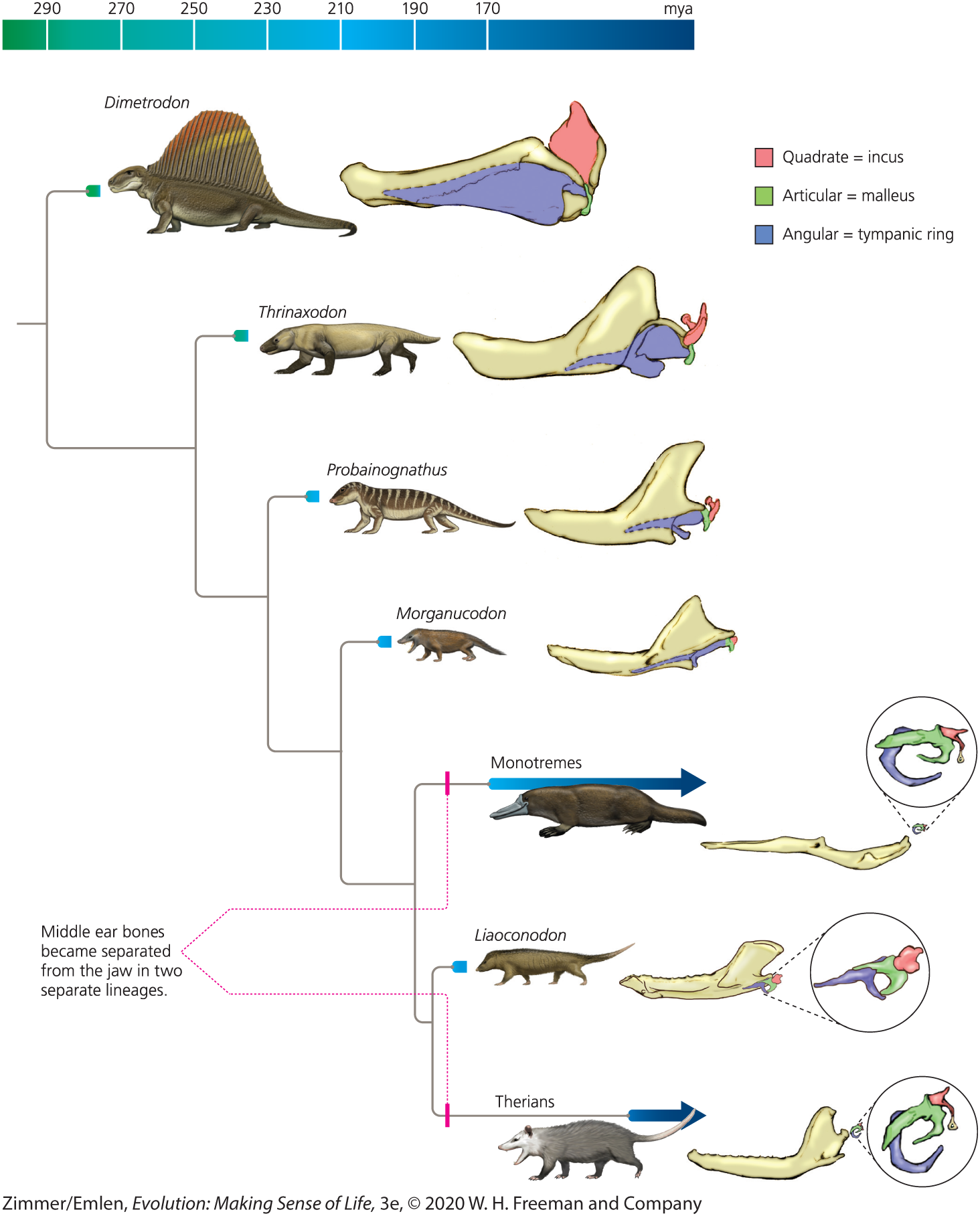
How Feather Dinosaurs Took Flight
We can link homologous traits in different taxa.
Exaptation: borrowed traits, traits that change function through course of evolution
The ancient wing was discovered and is very different from all other animals. Feathers fused with arm bone.
Question of whether feathers evolved to aid flight remained unanswered until we discovered birds and dinosaurs are connected. Theropods had well developed wings. Feathers protected nests and were used for mating as well, and thus we were not originally growing feathers for flight.
Gliding, thermoregulation, species recognition, mate attraction, keeping eggs warm in nest
Zhenyuanlong: vaned feathers, Projections off the quill form code. All the feather stick together and give strength of flight when grouped together. Strong but weigh very lightly.
First evidence of feathers was 190 mya, while flight was 150 mya. New evidence suggest flight evolved 3x in paraves clade.
Archaeornithura: Birds don’t have bony tails, they had a fanned tail like modern birds.
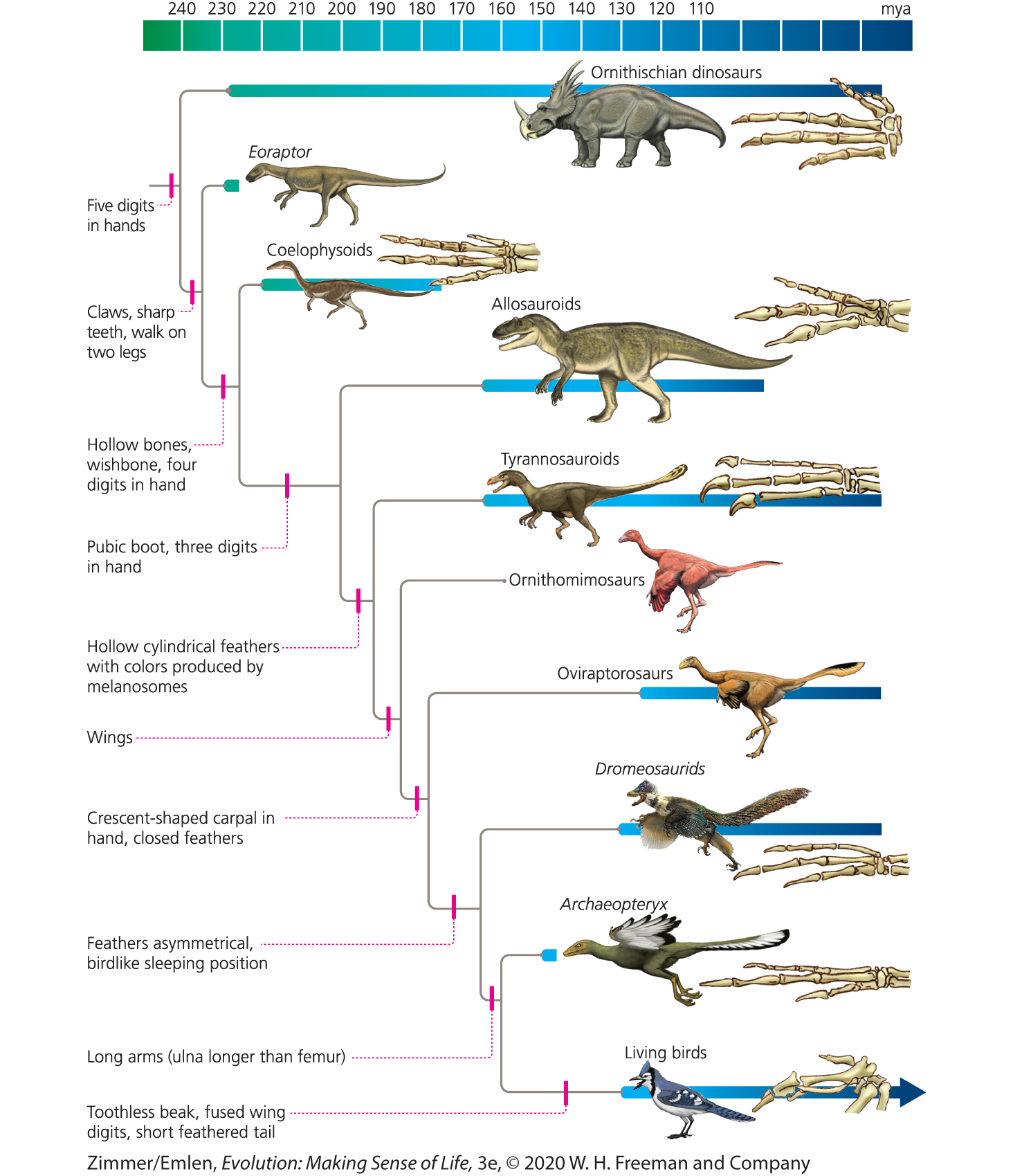
Extra Lecture Material
Characters: identifiable heritable traits
Character state: condition of the character
Ancestral: what character was had in past ancestors (primitive)
Derived: what character is more advanced and does not come from past ancestor
There is noticeable variation between taxa. We see this in size, colour, length of legs and antennas. Morphological variation occurs among the species.
Ch. 5 - Raw Material
The heritable variation among individuals. Joel Hirschhorn was looking into study height and different factors that explain it, like food, genetics, etc.
HMGA2 - carrying two copies increases height by 1 cm and the researchers have since discovered 800 loci that influence height.
RNA and DNA and how DNA encodes proteins and other molecules.
Variation occurs within a species or a population. Darwin found that heritable variation was necessary for natural selection.
Evolution’s Molecules: Proteins, DNA, and RNA
Gene: DNA, unit of inheritance, codes specific proteins.
Proteins: makes up most of the cell, dry weight. Structure and chemical reactions in the cell. Some carry information and molecules (hemoglobin w/ oxygen). They are all made up of the same 20 amino acids, and they’re used to build proteins. Some are surrounded by water, some repel. Based on whether the chain of amino acids are surrounded by or repel water, they fold spontaneously into complex 3D structures.
100 000 different kinds of proteins through a combination of 20 different amino acids.
primary structure (chain of amino acids) → secondary structure (a-helix and B-pleated sheet) → tertiary structure (3-D fold with interaction) → quaternary protein (protein)
DNA: info for assembling proteins. Linear molecules, made up of a limited set of building blocks. Stores recipes, like RNA. Made up of nucleotides. Fidelity of being able to compose proteins from DNA is up to the chemical composition. The double helix arrangement has a base sequence and mirror base sequence.
Sugar + phosphate group + base
Organized into chromosomes
Chromosomes: exist generally in pairs, and leads to ploidy variation (how many are there?). We are diploid.
RNA: protein-coding gene, produces protein through gene expression. Move from upstream to downstream end. RNA polymerase assembles a new string of nucleotides.
Messenger RNA: transcript copy of gene, encodes specific polypeptide
Ribosomal RNA: primary component of ribosome, catalytic activity
Transfer RNA: carries amino acid to ribosome for translation
snRNA: splicing and other functions
miRNA: gene regulation, silence genes by binding to mRNA. Messenger RNA travelling from chromosomes. Works with mRNA and is like glue, blocking messenger RNA.
Errors: mutations are transmitted each time the cell descends and makes new copies. The coiling could change and effect what and how it is read.
Sex chromosomes vs. autosomes.
DNA replication: essential for growth and reproduction. Mutations often introduced here.
Gene Regulation
20 000 protein-coding genes per person. 3800 are continually expressed in all the cells. The remaining are required in tissue at certain times, though not in all tissues. There are 30 trillion cells with each having millions of molecules. 3 particular molecules are especially important for life.
Gene control region: where a gene starts transcribing. Repressor stops. Transcription factors bind to enhancers in gene control.
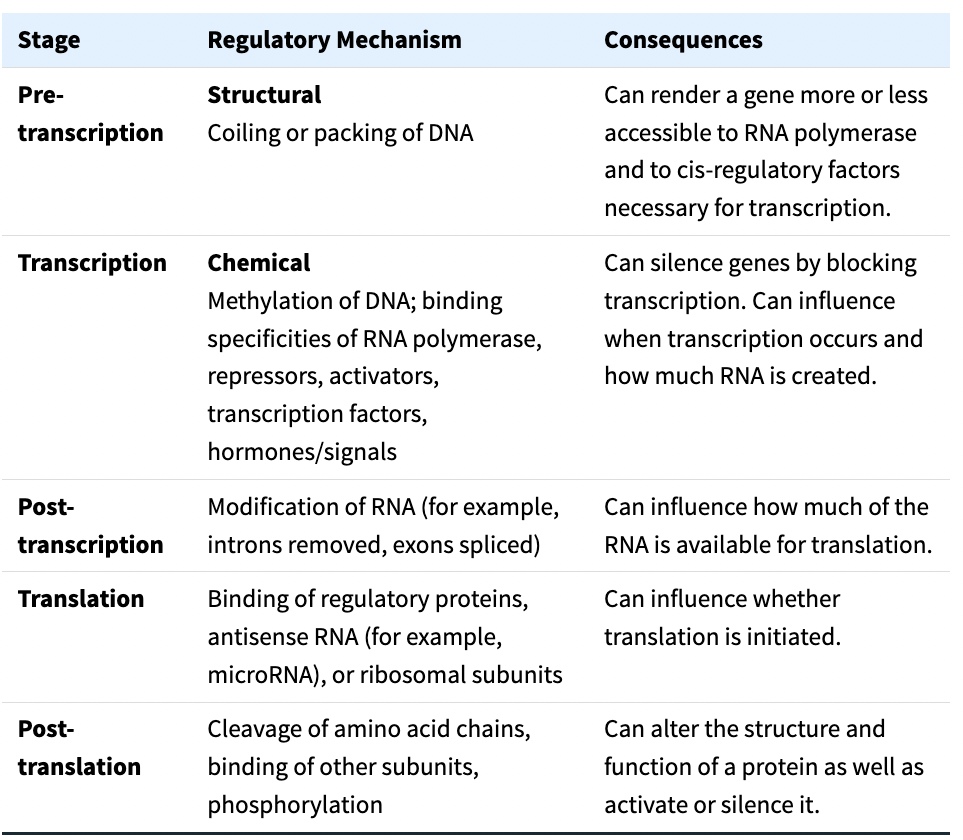
Gene regulation was discovered in the 1950s, with a repressor protein to work against E. coli eating lactose.
Some cells release hormones to bind to receptors and trigger a relay of signals.
RNA splicing, alternative splicing, methylation.
Alternative splicing: genes are pleiotrophy, how they have multiple roles. Our genes and polypeptides have multiple roles through alternative splicing. Make primary transcript, comes in with introns all in place, when it is chopped up, sometimes the orientation, order and inclusion is variable.
Sizing Up the Genome
Amount of DNA varies by species, especially amount of coding and non-coding.
Horizontal gene transfer occurs via plasmids
Mobile genetic elements: segments of human genome made up of parasite-life segments of DNA, with capacity to make new copies of themselves that can be reinserted into the genome
Pseudogenes: genes that no longer produce a functional molecule
Mutations: Creating Variation
Mutation: any change to the genomic sequence. Errors during DNA replication, can be harmful, beneficial or neutral.
Misread, UV solar radiation, chemical radiation can all be causes for mutation, or they at least increase the likelihood of one.
Types of mutations: point mutation, insertion, deletion, frameshift, duplication, inversion, chromosome fusion, aneuploidy, genome duplication.
Can be harmful, beneficial or neutral
Point mutation: Single nucleotide changes to alter codon.
Silent: still codes for tyrosine, synonymous
Missense: changes a single nucleotide.
Nonsense: codon changes to a STOP codon, non-beneficial, non-functional protein.
Frameshift: change the reading frame, insertion of a C nucleotide that changes the entire reading frame, almost always deleterious.
Indels: insertion deletions, where some have a set that others don’t
BA switching orientation can disrupt things from linking up during meiosis.
Lots of serine to proline mutations that cause big issues, because it forms a shape that causes kinks in protein and folds in on itself. Can block binding sites.
Transcription factors are encoded by genes and can affect the genes they regulate.
Somatic mutations: occur in soma/body cells, passed only to daughter cells
Germline mutation: occurs in cells that can be inherited within populations, heritable through eggs and sperm.
Craig Venter: first draft sequence of human genome was his genome
3.2 million places (nucleotides) differed just between his paired chromosomes
>100 million when consider humans from across the world (about 1/1000 bp)
Cis-regulatory elements: near/within focal gene. Slightly upstream, downstream, introns. eg. promoters, enhancers, silencers.
Trans-regulatory elements: often far away (different chromosomes), bind to cis-regulatory elements. eg. transcription factors, activators, repressors. Can depress or up gene expression based on what it binds to.
Heredity
Equation is 2n for how many different options of genotype you have, where n is the number of chromosome pairs you have.
Bacteria and Archaea have variation occur largely via mutation
Eukaryotes have variation more complex, only in germline mutations that are inherited, and sex introduces recombination.
Crossing over: one from each parent, duplicate, line up and cross arms, 4 haploid gametes differ in combination of alleles and number on their chromosome.
Meiotic recombination
Independent assortment: diploid organism, duplicates, they align and shuffle up the chromosomes they provide to their meiotic cell.
The Complex Link Between Most Genotypes and Phenotypes
Genotypes consist of alleles, while phenotype is given rise by the genotype. Usually not associated with a single allele (simple genetic polymorphism), where they are controlled by many (quantitative traits).
Phenotype options
Morphological (antlers)
Developmental (learning, maturing, body plan)
Physiological (metabolism)
Behavioural (mating display)
Mendel’s experiment should not be reflective of most genetic traits: the traits are dominant and recessive, and were controlled by alternative alleles at one gene. They are simple and discrete phenotypes, as opposed to in-between states.
Genetic mapping by Hischhorn (height) is more realistic for traits we have. Used quantitative locus finding.
Polymorphism: any genetic difference among multiple individuals in a population.
Allele: different forms of a gene
Genetic polymorphism: the presence of two or more variant forms of a specific DNA sequence that can occur (difference in DNA sequence explaining red vs. black hair)
Polyphenism: the phenomenon where two or more distinct phenotypes are produced by the same genotype (winged vs. flightless morphs) based on environment. Form of phenotypic plasticity. Beetles determined by their critical period and how much food is had during a critical period.
Quantitative traits have continuous phenotypic variation
How Do Genes Respond to the Environment
Environment is anything that interacts with promoter - part of gene’s environment
Morphogens: molecular signals that move through a field of cells. Genes turned on in one location can be turned off in another location.
Phenotypic plasticity: potential variation based on what is more sensitive to environmental stimuli
Is a flexible adaptive strategy that organisms can tailor phenotypes to surroundings.